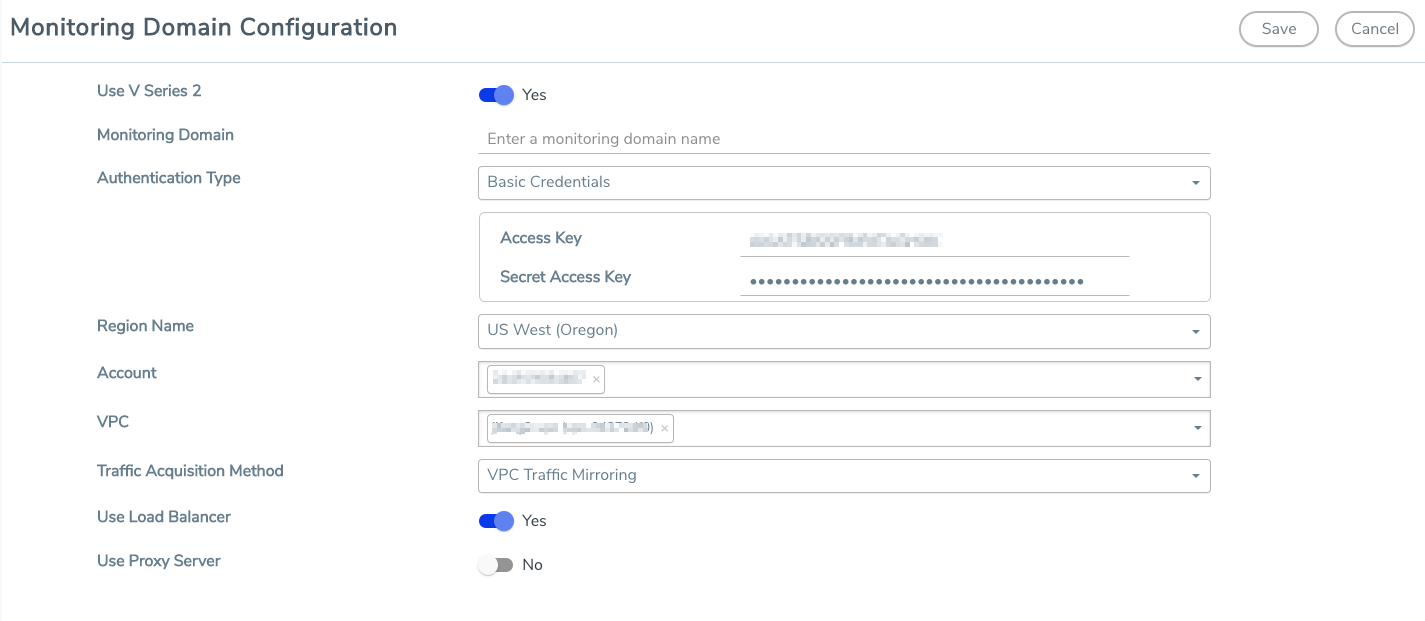Configure an External Load Balancer
You can use your own load balancer to uniformly distribute the traffic from AWS target VMs to V Series 2 nodes. The load balancer distributes the traffic to the V Series 2 nodes and the GigaVUE-FM auto-scales the V Series nodes based on the traffic. GigaVUE-FM creates a traffic mirror from the target VMs to the load balancer that all the targets must have the same traffic load balancer destination. Load balancer forwards the traffic to the V Series 2 nodes and the AWS Auto Scaling group monitors the load of all V Series nodes. AWS Auto Scaling group can add or remove nodes if the traffic load is heavy or low.
You can configure an external load balancer through AWS and GigaVUE-FM, Refer to the following sections for more details:
Configure an external load balancer in AWS
To configure an external load balancer in AWS:
- In the Target Groups page, click Create target group and the Create target group wizard appears. Enter or select the following values and create the target group.
- Select IP addresses as the target type.
- Enter a name for the target group.
- Select the UDP as the Protocol and 4789 as the port number.
- Select the VPC of your target group where the targets are registered.
- Select TCP as the Health check protocol in port number 8889 with 10 seconds health check interval.
Note: For detailed instructions, refer to Create a target group for your Network Load Balancer topic in the AWS Elastic Load Balancing document.
- Navigate to the Load Balancer page and click Create Load Balancer the Create elastic load balancer wizard appears. Enter or select the following values and create the load balancer.
- Select Network Load Balancer as the load balancer type and click Create.
- Enter a name for the Network Load Balancer.
- Select Internal load balancer as the Scheme.
- Select the VPC for your targets (V Series Nodes).
- Select the regions/zones and the corresponding subnets.
- Select UDP as the Listener Protocol with Port number 4789.
Note: For detailed instructions, refer to Create a Network Load Balancer topic in the AWS Elastic Load Balancing document.
- Navigate to the Launch Templates page and click Create launch template the Create launch template wizard appears. Enter or select the following values and create the launch template.
- Enter a name for the launch template.
- Select the AMI of the V Series node.
- Select t3a.xlarge as the instance type.
- Select a Key pair for the instance.
- Select VPC as the Networking platform.
- Add required number of Network Interfaces.
Note: For detailed instructions, refer to Creating a launch template for an Auto Scaling group topic in the AWS EC2 Auto Scaling document.
- Navigate to the Auto Scaling groups page, and click Create an Auto Scaling group the Create Auto Scaling group wizard appears. Enter or select the following values and create the Auto Scaling group.
- Enter a name for the Auto Scaling group.
- Select an existing launch template.
- Select the VPC and subnet.
- In the Group size section, enter the value for minimum and maximum capacity.
- In the Scaling policies section, select Target tracking scaling policy and choose Average network in (bytes) for the Metric type with 1000000000 (bytes) as target value and 300 seconds warm up value.
- (optional) Add Tags to the instances.
Note: For detailed instructions, refer to Creating an Auto Scaling group using a launch template topic in the AWS EC2 Auto Scaling document.
In the Instances page, you can view the V Series 2 node instance deployed by the load balancer and use the same
Configure an external load balancer in GigaVUE-FM
To configure an external load balancer in GigaVUE-FM:
- In the Monitoring Domain Configuration page, select VPC Traffic Mirroring as the Traffic Acquisition method. Refer to Create a Monitoring Domain for detailed information.

- For the Use Load Balancer field, select Yes.
- Click Save and the AWS Fabric Launch Configuration page appears.

- In the AWS Fabric Launch Configuration page, select the following for the load balancer.
- Select the Load Balancer configured in AWS
- Select the Auto Scaling Group configured in AWS
For the remaining field description, refer to Configure GigaVUE Fabric Components in GigaVUE-FM.
- Click Save to save the configuration.



